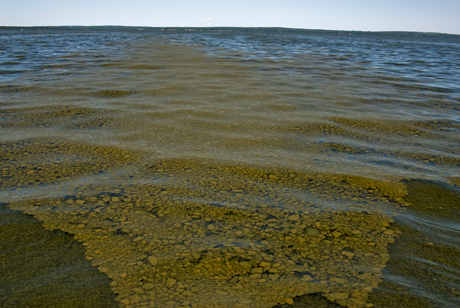Alberta Health Services has issued a cyanobacteria (blue-green algae) advisory for Eagle Lake, located southeast of Strathmore.
![]()
The health authority says cyanobacteria has been identified in the lake’s waters and is advising visitors to:
-
Avoid all contact with cyanobacterial blooms. If contact occurs, wash with tap water as soon as possible.
-
Do not swim or wade or allow your pets to swim or wade in any areas where cyanobacteria is visible.
-
Do not feed whole fish or fish trimmings from this lake to your pets.
-
Consider limiting human consumption of whole fish and fish trimmings from this lake, as it is known that fish may store toxins in their liver. (People can safely consume fish fillets from this lake).
-
As always, visitors and residents are reminded to never drink or cook with untreated water directly from any recreational body of water, including Eagle Lake, at any time. Boiling of this water will not remove the toxins produced by cyanobacteria.
-
An alternate source of drinking water should also be provided for pets and livestock while this advisory is active.
AHS says cyanobacteria is naturally occurring and often becomes visible when weather conditions are calm. Appearing like scum, grass clippings, fuzz or globs on the surface of water, cyanobacteria can be blue-green, greenish-brown, brown and/or pinkish-red, and often smell musty or grassy.
People who come in contact with visible cyanobacteria or who ingest water containing cyanobacteria may experience skin irritation, rash, sore throat, sore red eyes, swollen lips, fever, nausea and vomiting and/or diarrhea. Symptoms usually appear within one to three hours and resolve in one to two days. Symptoms in children are often more pronounced; however, all humans are at risk of these symptoms. Exposure to the bacteria may be fatal to pets.
Weather and wind conditions can cause algae blooms to move from one location in the lake to another. As such, the advisory will remain in effect for Eagle Lake until further notice.
AHS says waters of Eagle Lake in which the cyanobacterial bloom is not visible can still be used for recreational purposes, even while the health advisory is in place.
canobacteria (also called blue-green algae) are types of bacteria found in many lakes, ponds, and other bodies of water. Many types of cyanobacteria can control whether or not they float (buoyancy), which lets them move up and down in the water.
Cyanobacteria can multiply in the summer, causing large growths called blooms. Blooms can be blue-green, greenish-brown, or pinkish-red and can smell musty or grassy. They often look like scum, streaks, or mats on the water surface or throughout the water, and often form when conditions are calm.
Some types of cyanobacteria that form blooms produce toxins that can affect health. Most toxins break down within days, but they can remain in the water at low levels for weeks after a bloom disappears. AHS says you cannot tell if a bloom is harmful from how it looks — if you see a bloom, assume it is toxic and take precautions.
Children might be more at risk for getting sick because they often spend more time in the water and may swallow contaminated water by accident. Illness and deaths of livestock, pets, and wildlife have been linked to animals drinking water containing toxins from cyanobacteria blooms.
Sign up to get the latest local news headlines delivered directly to your inbox every afternoon.
Send your news tips, story ideas, pictures, and videos to news@discoverairdrie.com. You can also message and follow us on Twitter: @AIR1061FM.
DiscoverAirdrie encourages you to get your news directly from your trusted source by bookmarking this page and downloading the DiscoverAirdrie app.
